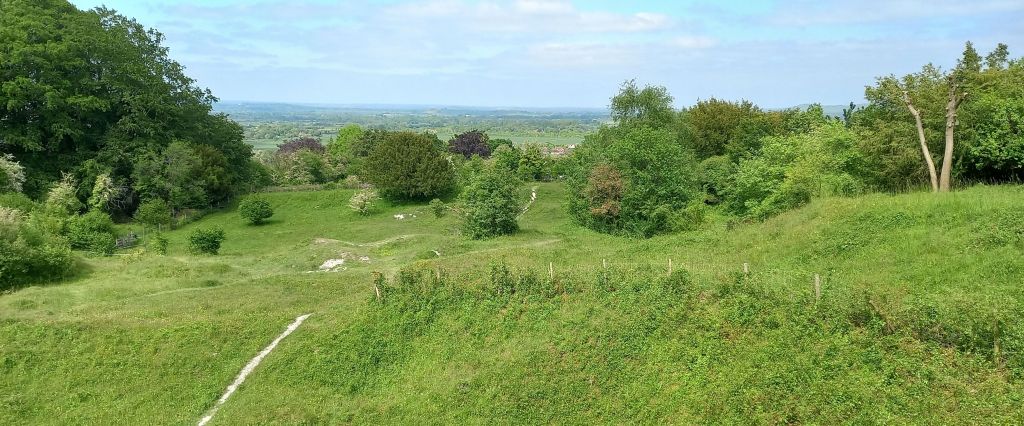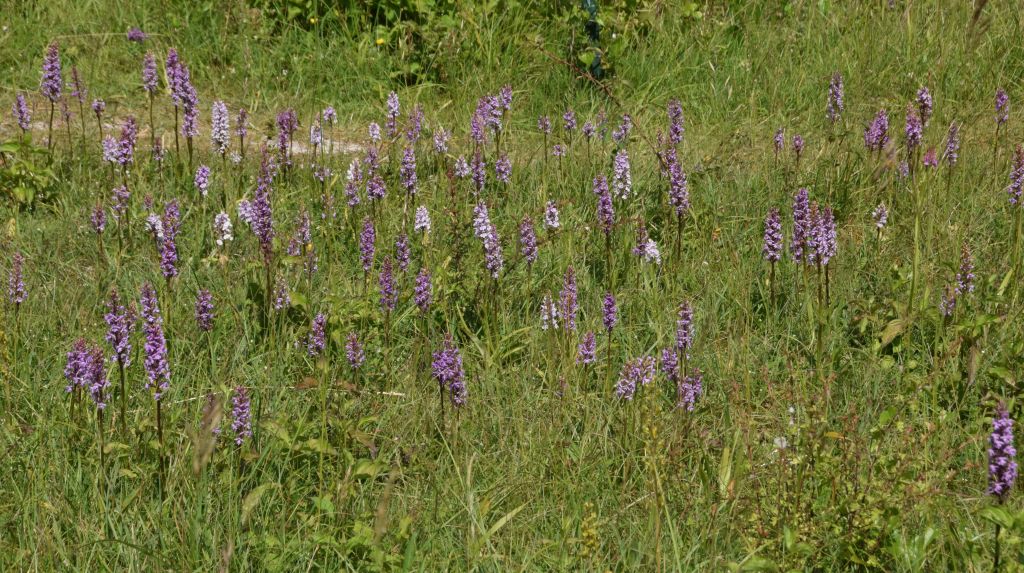Things begin to get serious at this stage of the season as more sought after wild Orchids enter the mix. The species experienced in Oxon so far are pretty widespread, but on the other side of the Chiltern escarpment to the east lie sites of renown offering specialities that draw enthusiasts each year in numbers, and those I now set out to explore.
I began at Homefield Wood (SL7 2HL – SU814867) early on a bank holiday Monday (29th), having been briefed that the Orchid season was well under way there. The site is renowned as one of only three nationally to host Military Orchid, and they certainly thrive here on today’s evidence. There are around 500 plants, some across a south-facing slope just inside the BBOWT reserve entrance, but mainly in an enclosed meadow away to the left that may or may not be publically accessible at the Trust’s discretion.

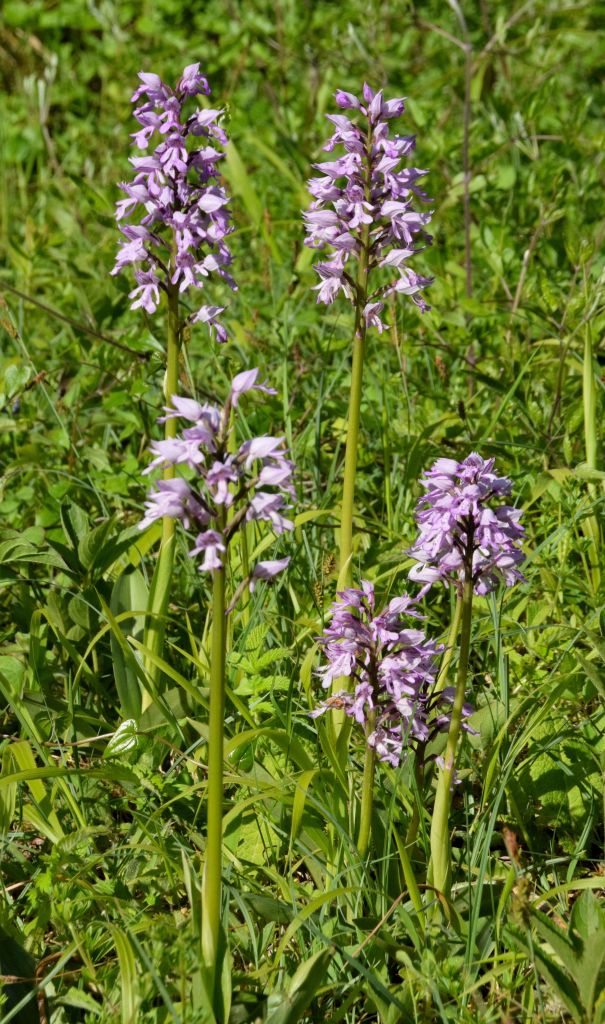

This mid-May to mid-June flowering species (pictured above) is well-distributed around central and northern Europe but one of Great Britain’s rarest. The flowers, clustered in a conical spike on a robust stem up to 60 cm tall, resemble human figures with outstretched arms, big feet and wearing a soldier’s dress helmet. The name also arises from vertical lines of dots on the petal below that hood which suggest buttons on a military tunic. This item grows on chalk grassland in the shelter of broad-leaved woods, and thrives especially in shaded old pasture with light scrub such as the enclosure here.
A second site stand-out was the rather intriguing Fly Orchid that offers a prime example of insect mimicry in plants to assist pollination. The well-spaced flowers on slender spikes resemble perched flies, complete with eyes and antennae. The cleverest bit is this Orchid does not produce nectar but a scent of female Digger Wasps’ sexual pheromones, so what would any passing male do? And thus the plant is pollinated. Uncommon in the Chilterns, these are plants of Beech wood edges and scrub on chalk and limestone soils.

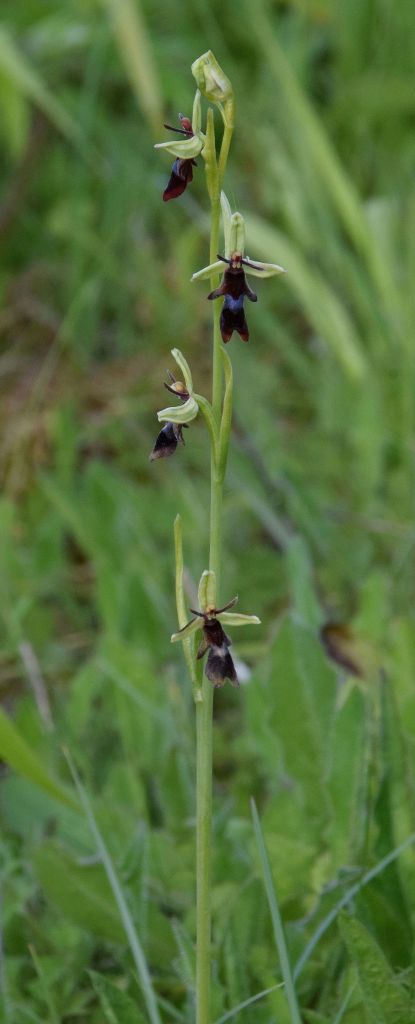

I will admit to feeling a little underwhelmed by these seriously skinny items, that due to the minuteness of the flowers were difficult to gain sharp images of, but the left and centre ones in this sequence were the best I could manage (click to enlarge). Other new (for me) Orchids encountered on the day were two of the shade-loving White Helleborine (right, above), and a good-sized clump of Common Twayblade.
I encountered more White Helleborine three days later (1st) on a first visit to BBOWT Grangelands (HP27 0NB – SP828050) where good numbers grow along the edge of neighbouring Pulpit Wood (pictured below). One of the commoner of the Helleborine group of Orchids, this is a Beech wood specialist that occurs on calcareous soils through May and June, growing to 60cm in height. Since this plant is self-pollinating the creamy-white, egg-shaped blooms rarely open fully, so the specimen in the right hand picture was a bit of a find. Only common in southern English chalk and limestone regions, they take around 10 years to develop fully from seed. So I assume the larger items in these pictures were the more mature amongst my haul. Most at all four of this post’s sites had between three to six flowers at the top of the stem. I rather like them and enjoyed their elegance and simplicity.
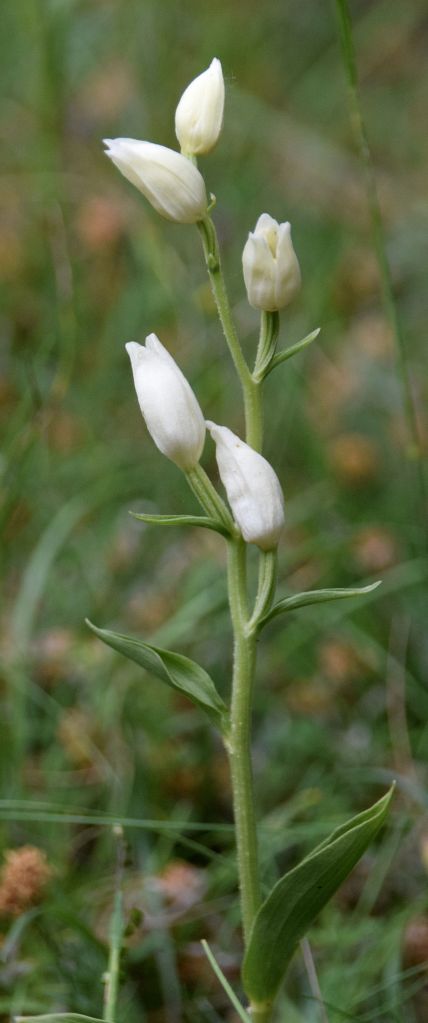
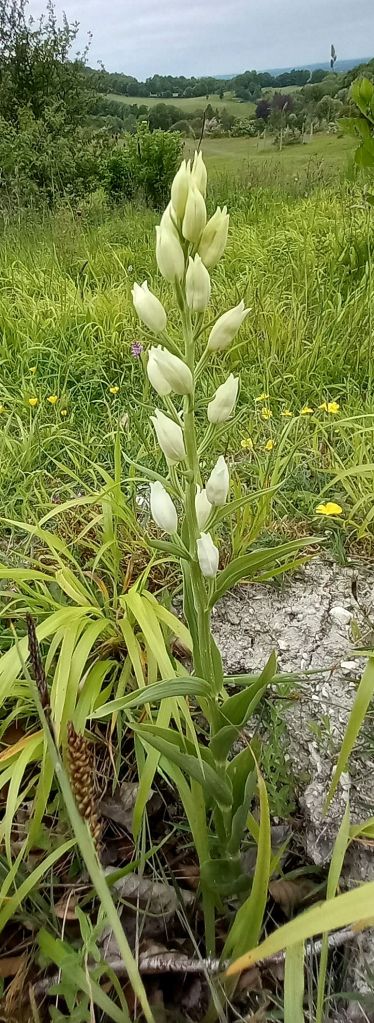
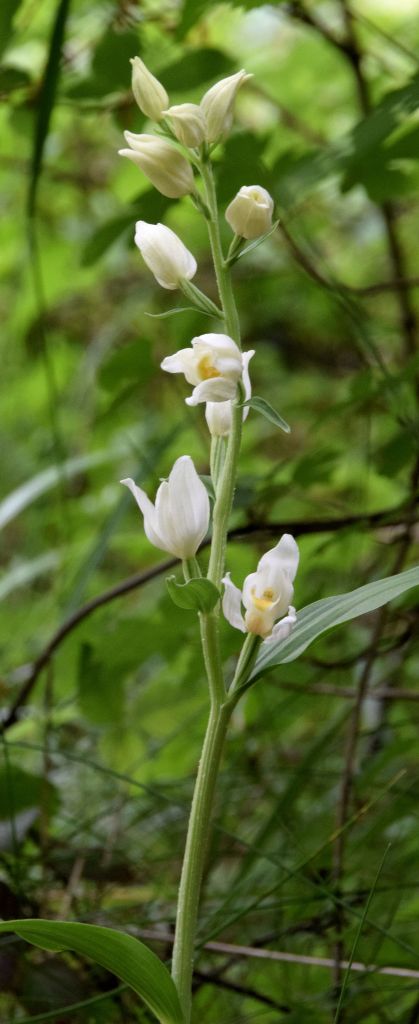
Aston Clinton Ragpits
Masses of Common Spotted Orchid were getting going here, but it seemed too early for Chalk Fragrant. I nonetheless moved on seven miles to BBOWT Aston Clinton Ragpits (HP22 5NF – SP888107) which is renowned for a profusion of the latter. There young Chalk Fragrant Orchid were indeed erupting from the ground in abundance, together with Common Spotted across the former quarry site.
The first-named is the more delicate looking of the two and occurs from mid-May to July in dry and open chalk and limestone grassland such as this. The 20 – 50 flowers on densely packed, cylindrical spikes may range in tone from pink through mauve to reddish-purple, and occasionally white. They typically grow to 30 cm tall but can reach 50 cm or more. As the name suggests a quite intense sweet perfume is emitted, especially at dusk to attract butterfly and moth pollinators.
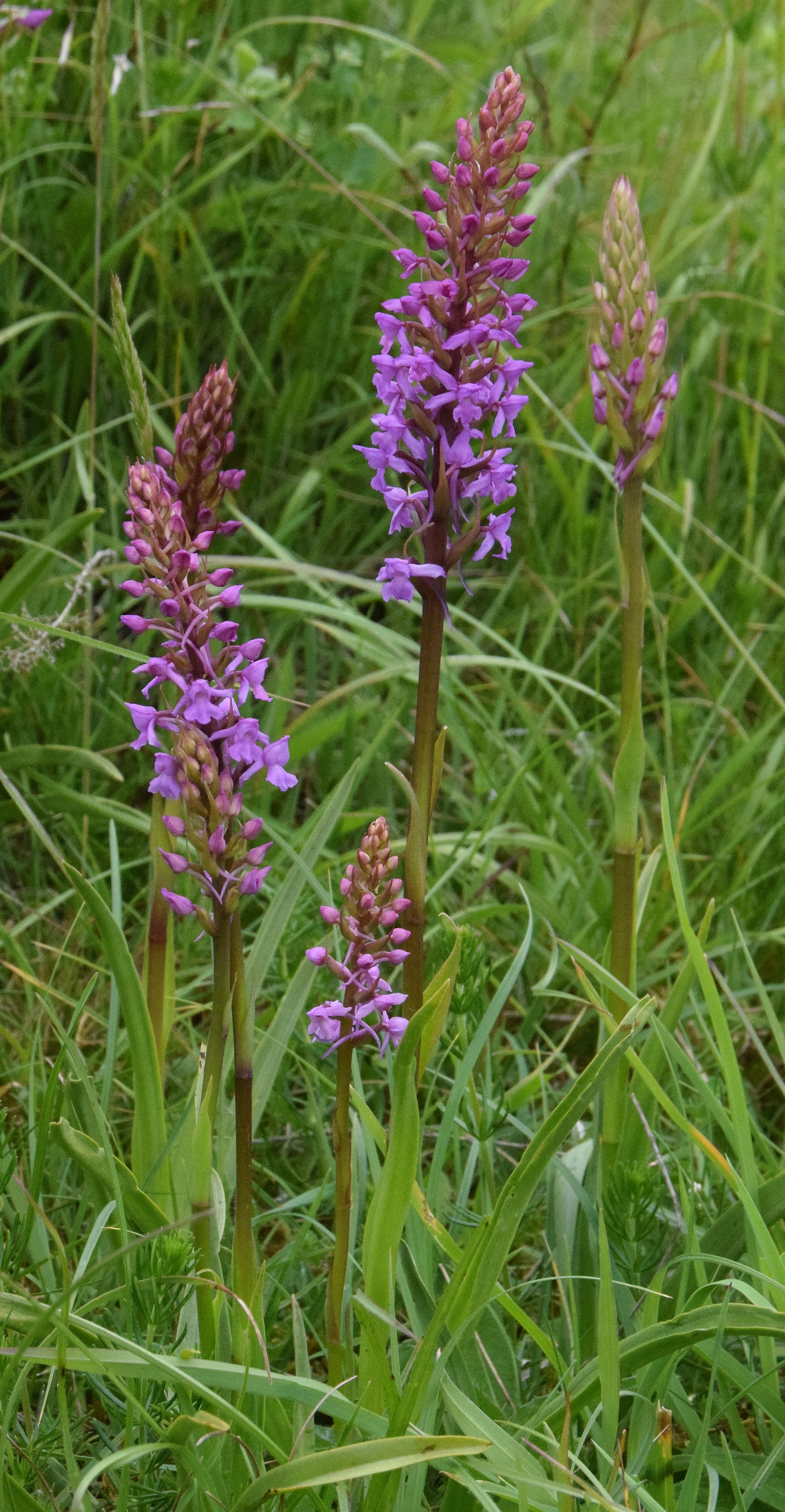
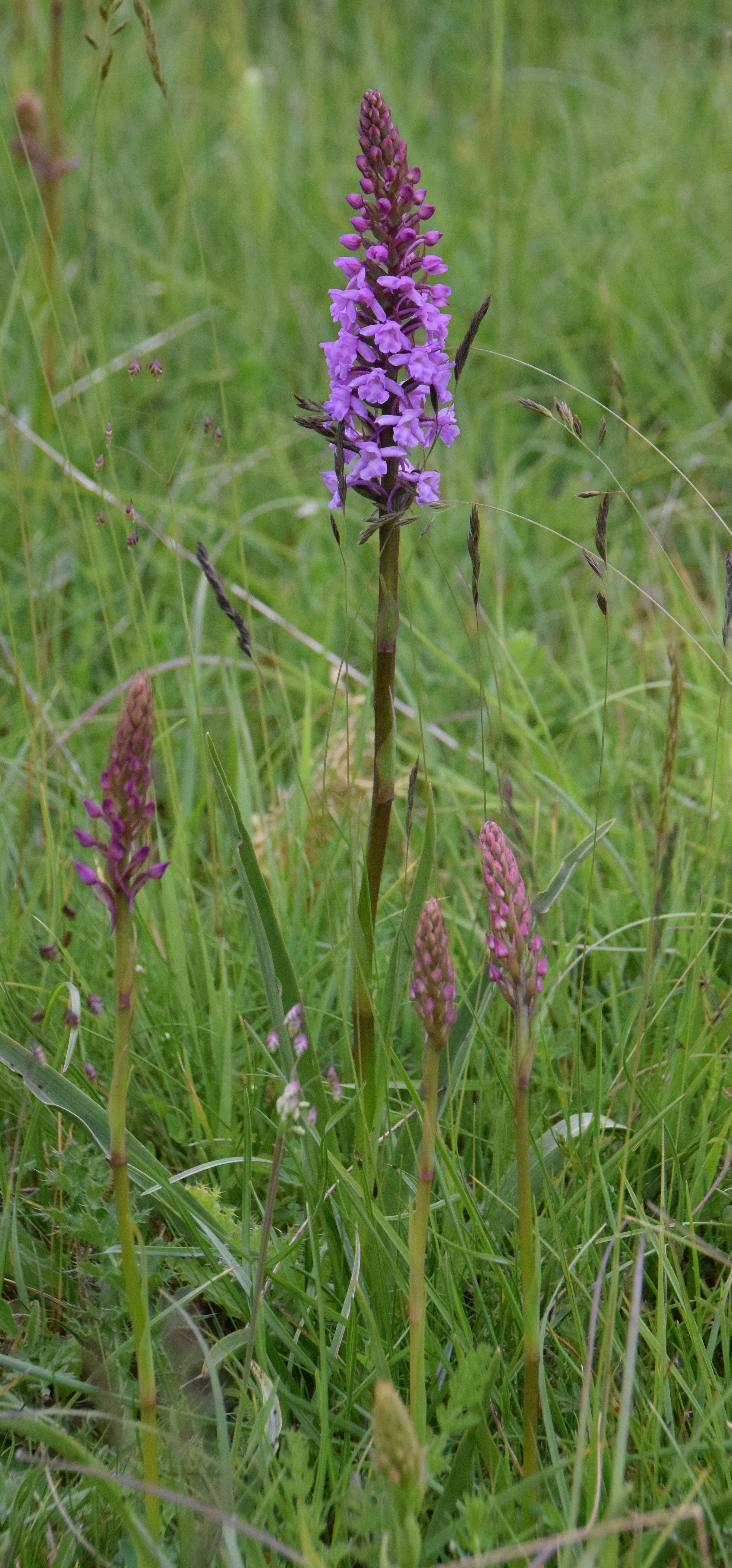
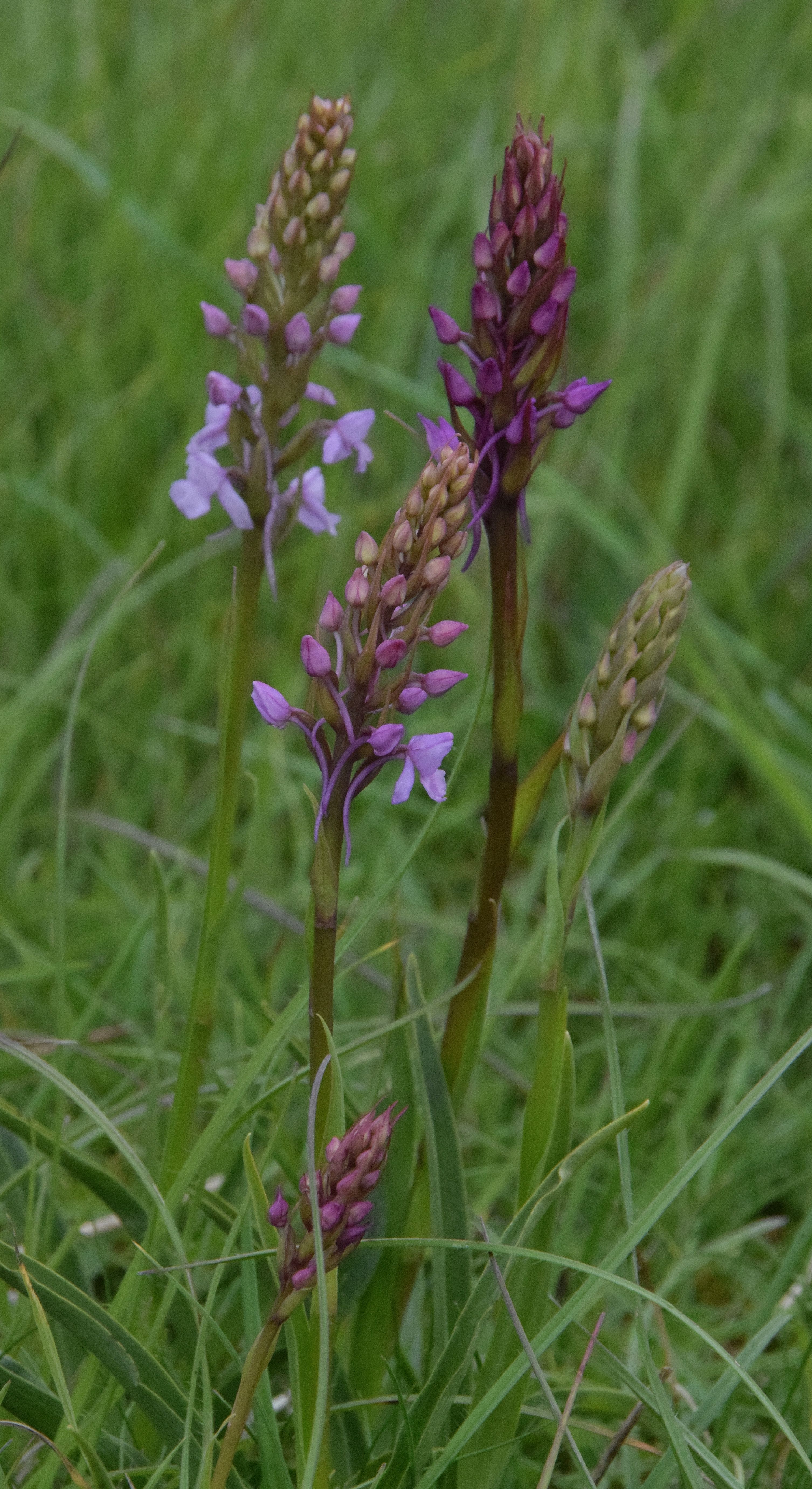
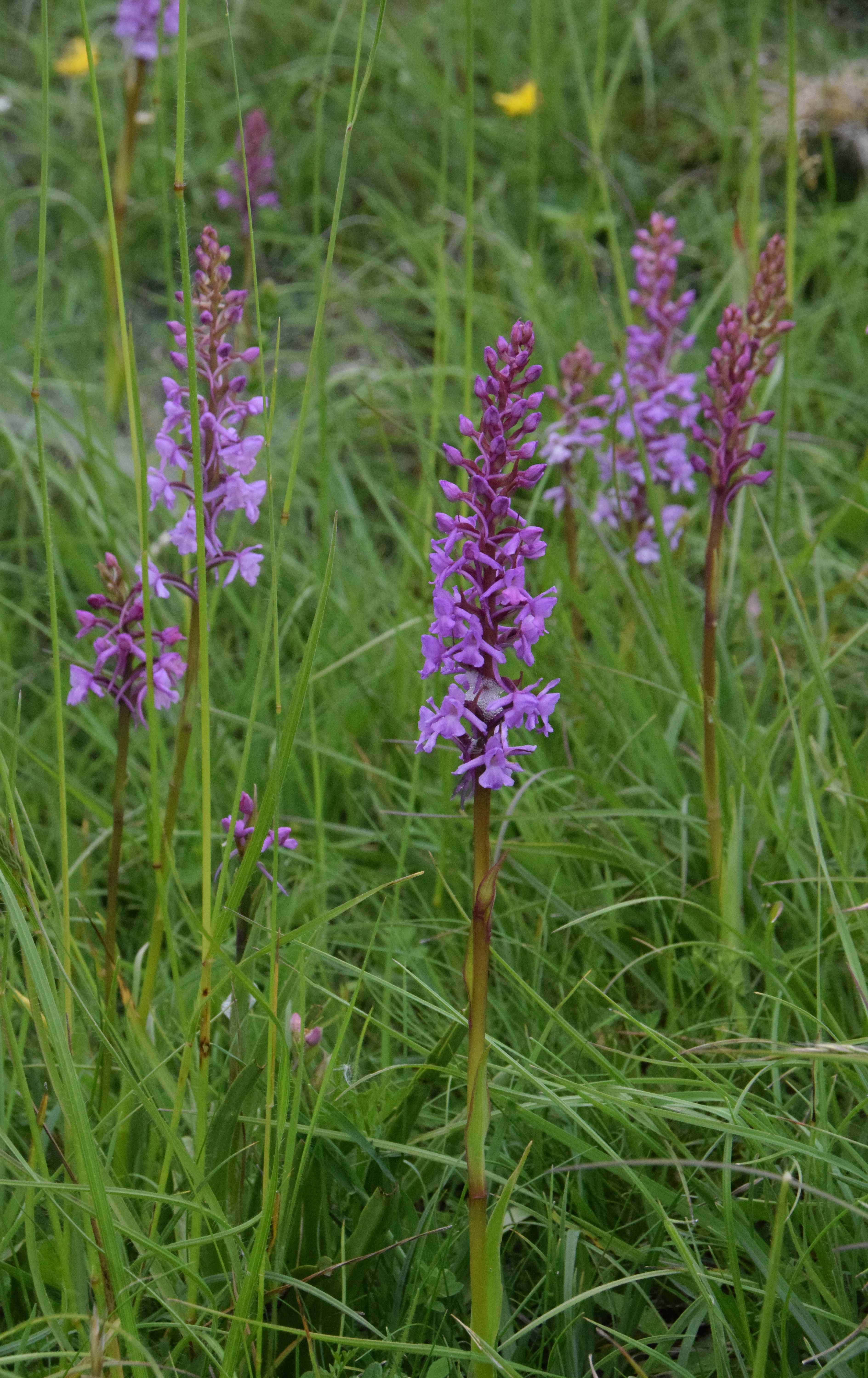
Young Chalk Fragrant Orchids
For me the stand-out in this location was numbers of Greater Butterfly Orchid (pictured below). I had observed these twice before in the region but enclosed in protective wire cages. Not so here and in an unfettered state I could appreciate properly their subtle and delicate beauty. This plant prefers light shade and is often found along woodland edges or in clearings, but it also occurs on chalk grassland. The greenish-white, rather waxy-looking flowers are loosely clustered on pale stems to 40 cm. As the name suggests they resemble hovering butterflies. At night a sweet scent of vanilla is omitted to attract the Hawkmoth pollinators that have suitably long probosci to enter the particular structure of the flowers.
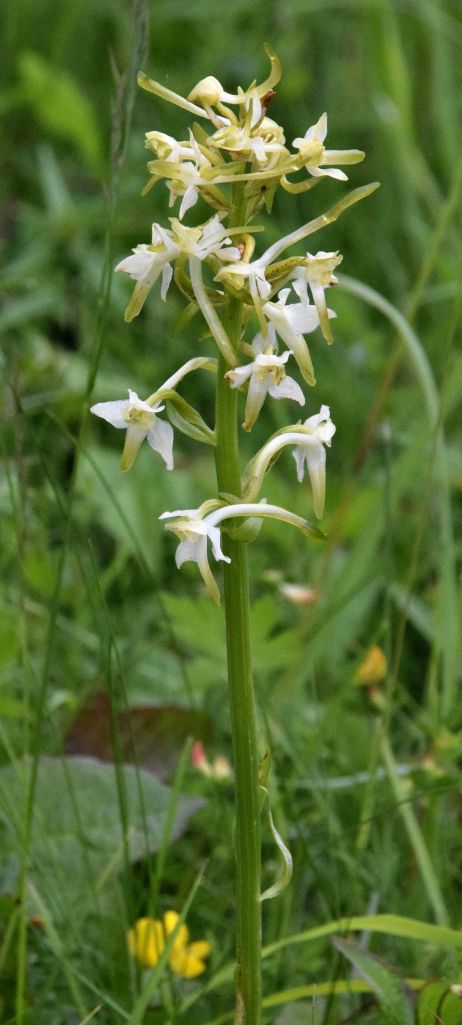
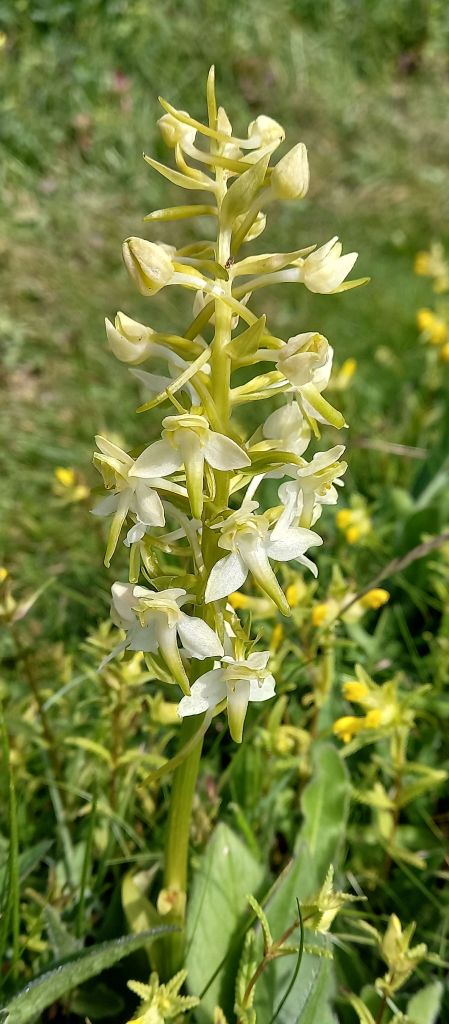
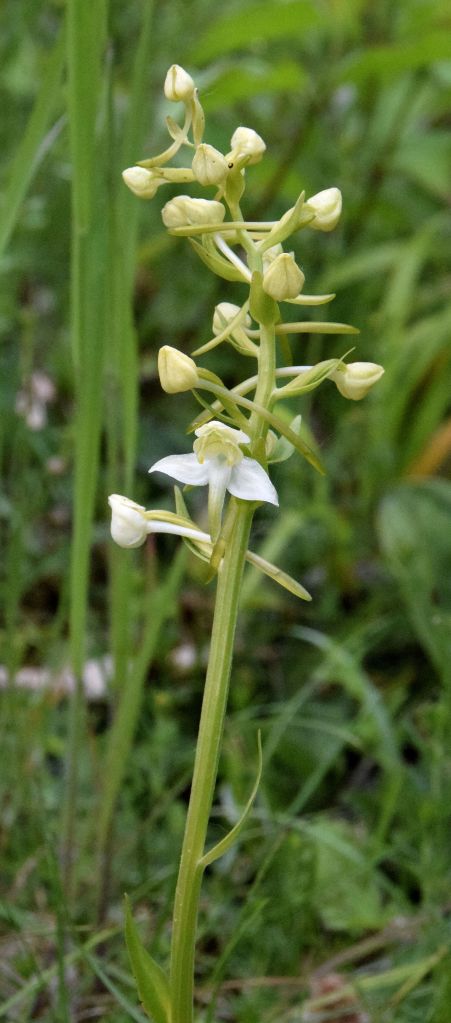
An irony here was how after habitual frustration at grey conditions while butterflying I was now cursing the afternoon sun for making things too bright and glary for taking pictures of wild plants. So on 2nd I returned early in the morning to attempt images in a more suitable light. It should be apparent which of the above sequence were gained on each day. The duller light was more suitable for gaining adequate studies of Common Twayblade that grows in profusion across the Ragpits.
This inconspicuous plant is widespread though localised from May to July in a wide range of habitats: chalk downland, open woodland, fens, quarries; along disused railway lines and at arable field edges. It emits a musk-like odour to attract insect pollinators. The name refers to the pair of broad oval leaves at the base of the stem. The minuteness of the yellow-green flowers on long and wispy stems (pictured below) makes them difficult to capture detailed pictures of, but the following are my better results. Shorter specimens best conveyed their blooms’ resemblance to clusters of tiny people, but the great majority were much taller and often in extensive clumps.
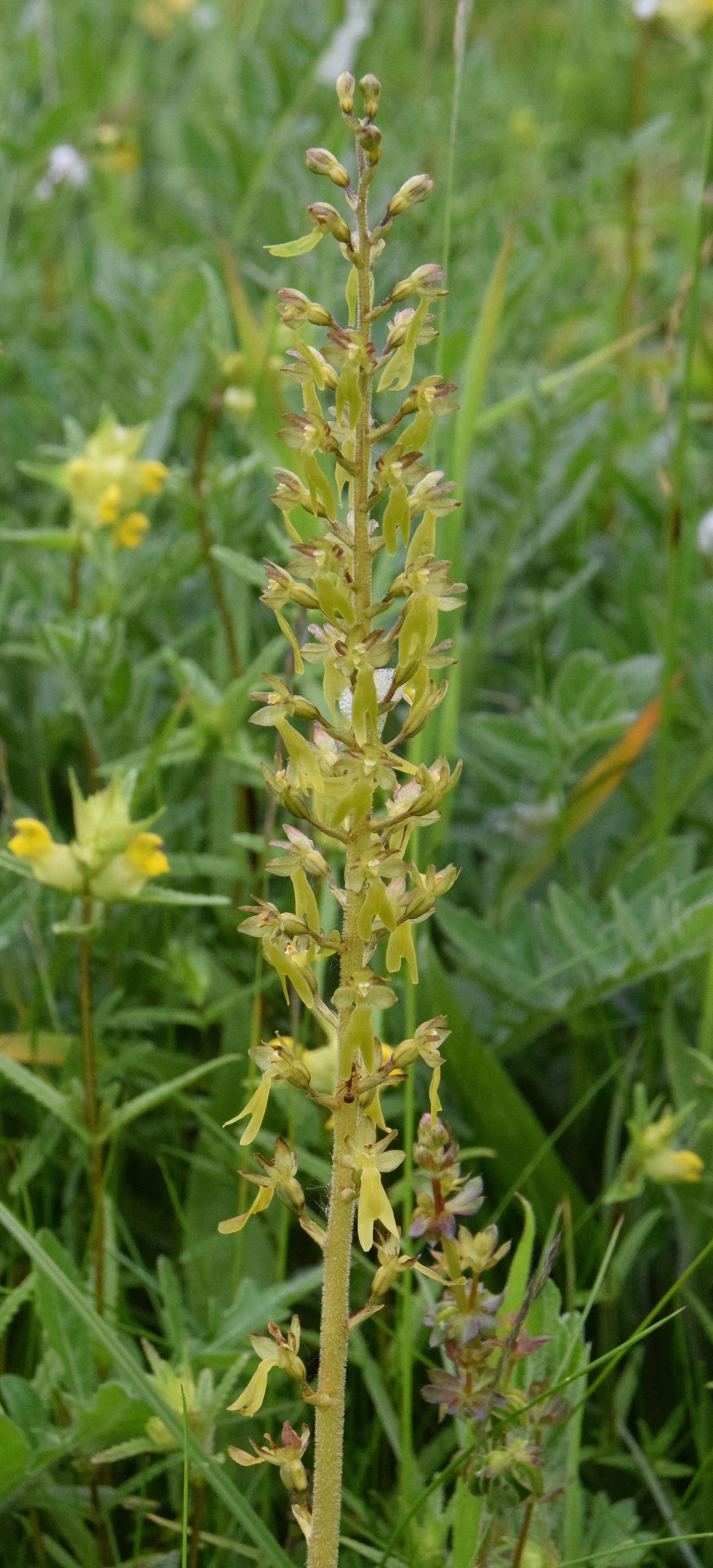
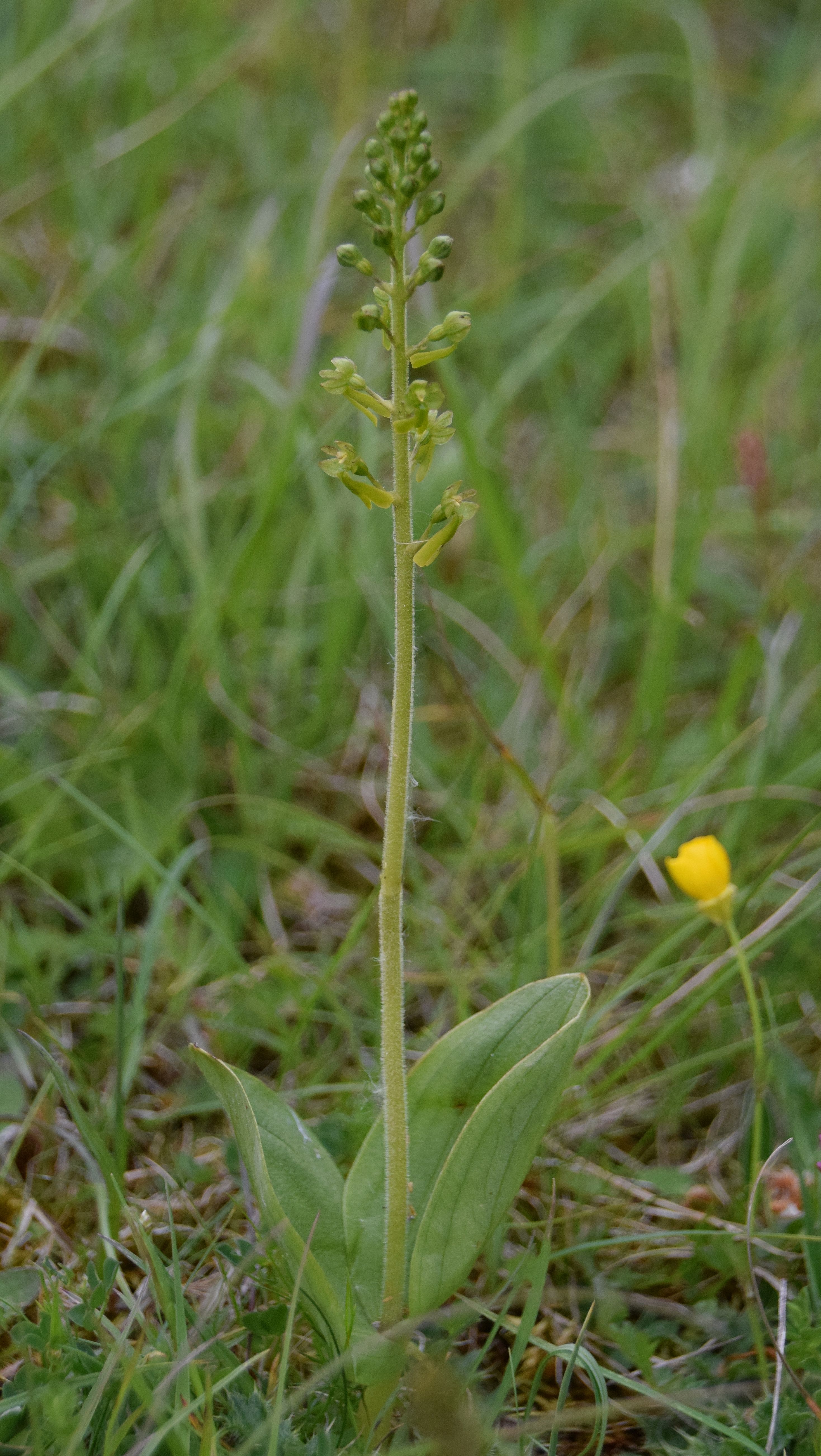
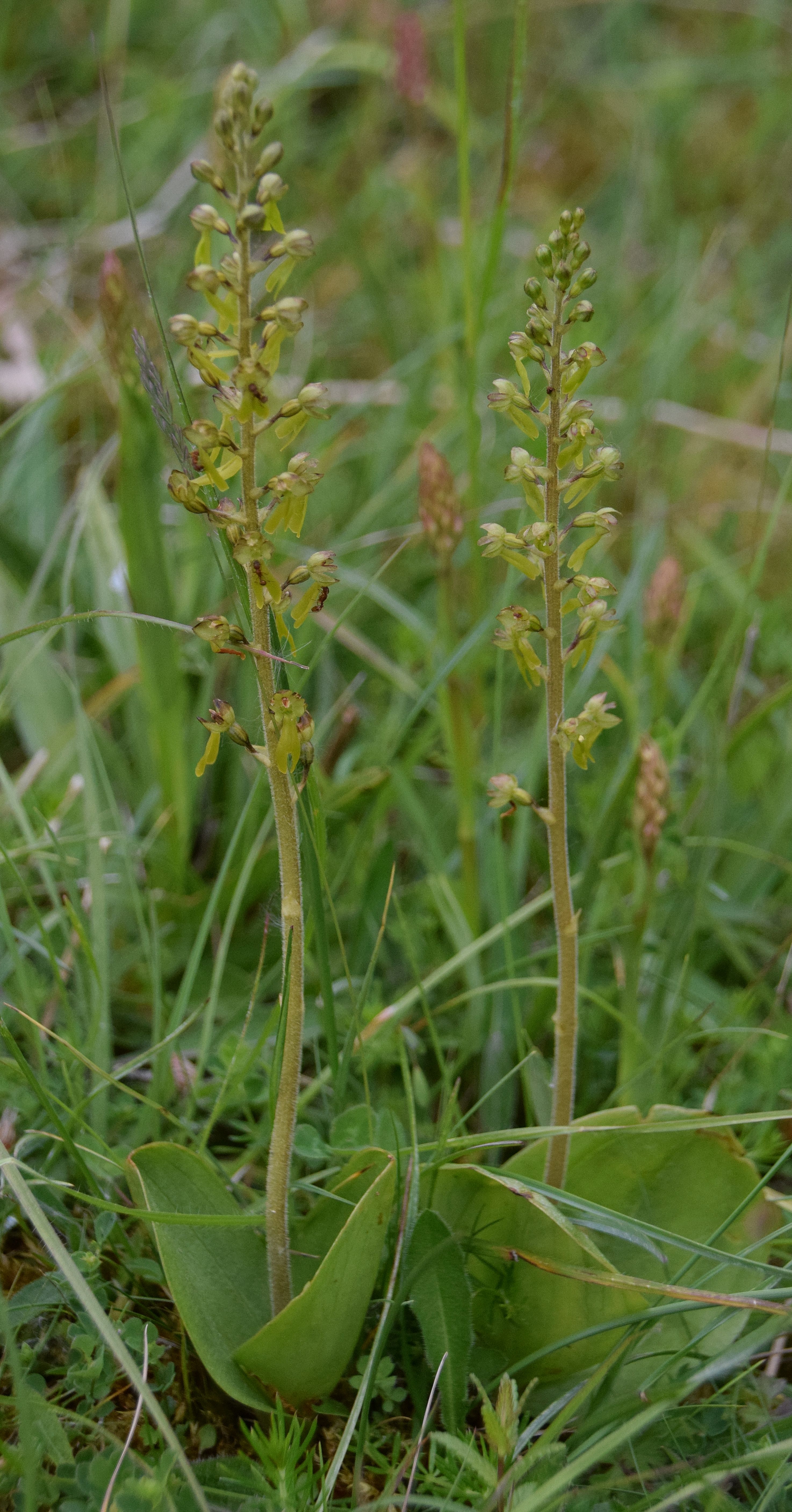
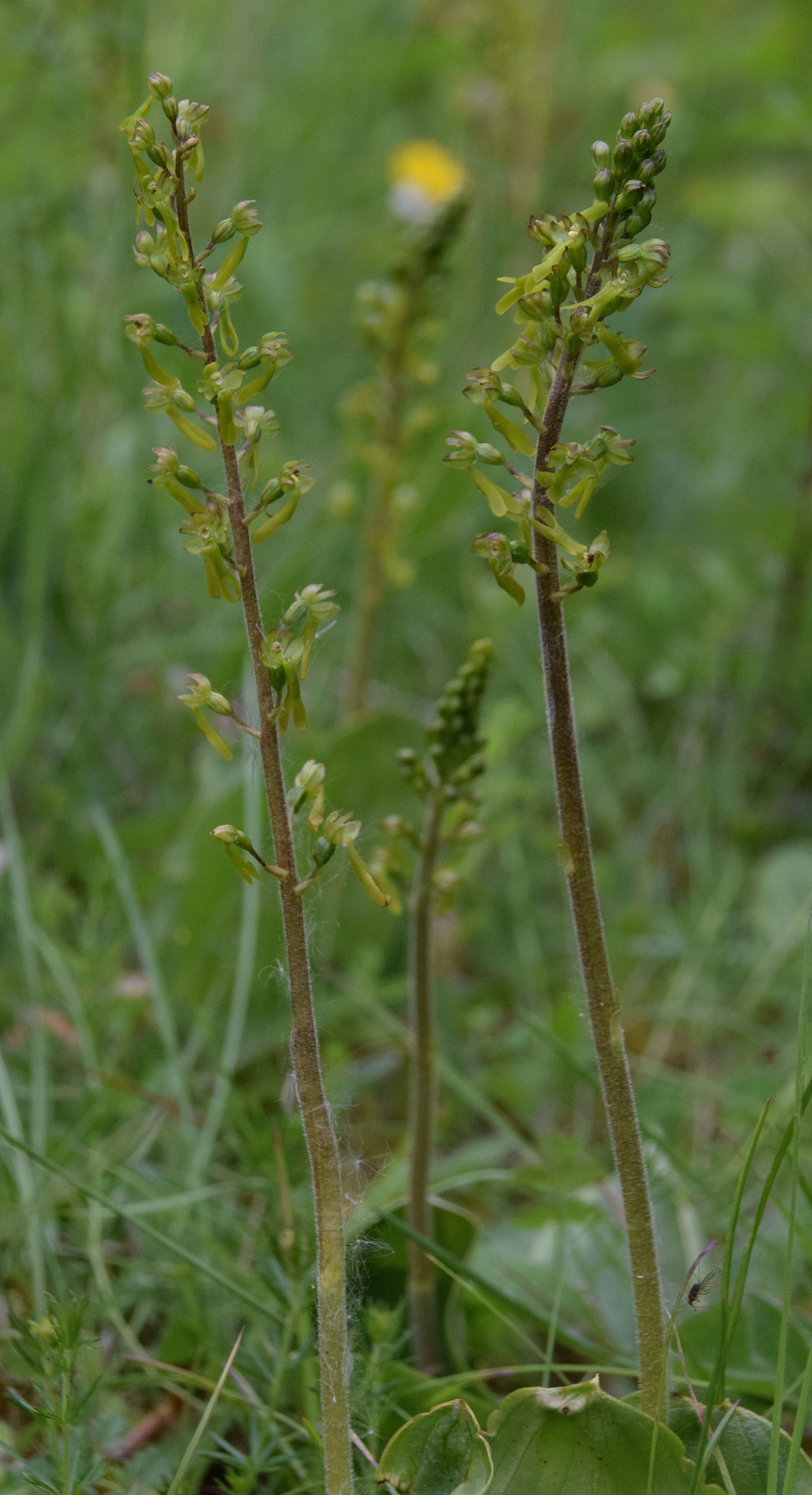
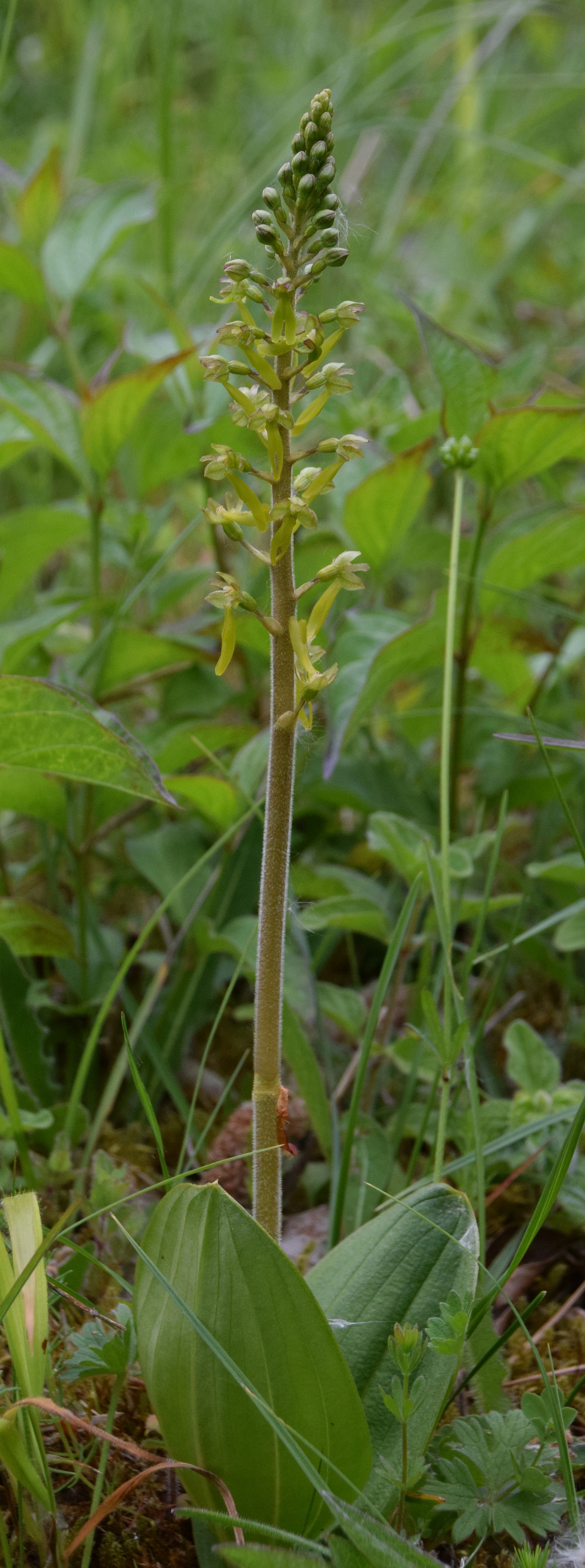
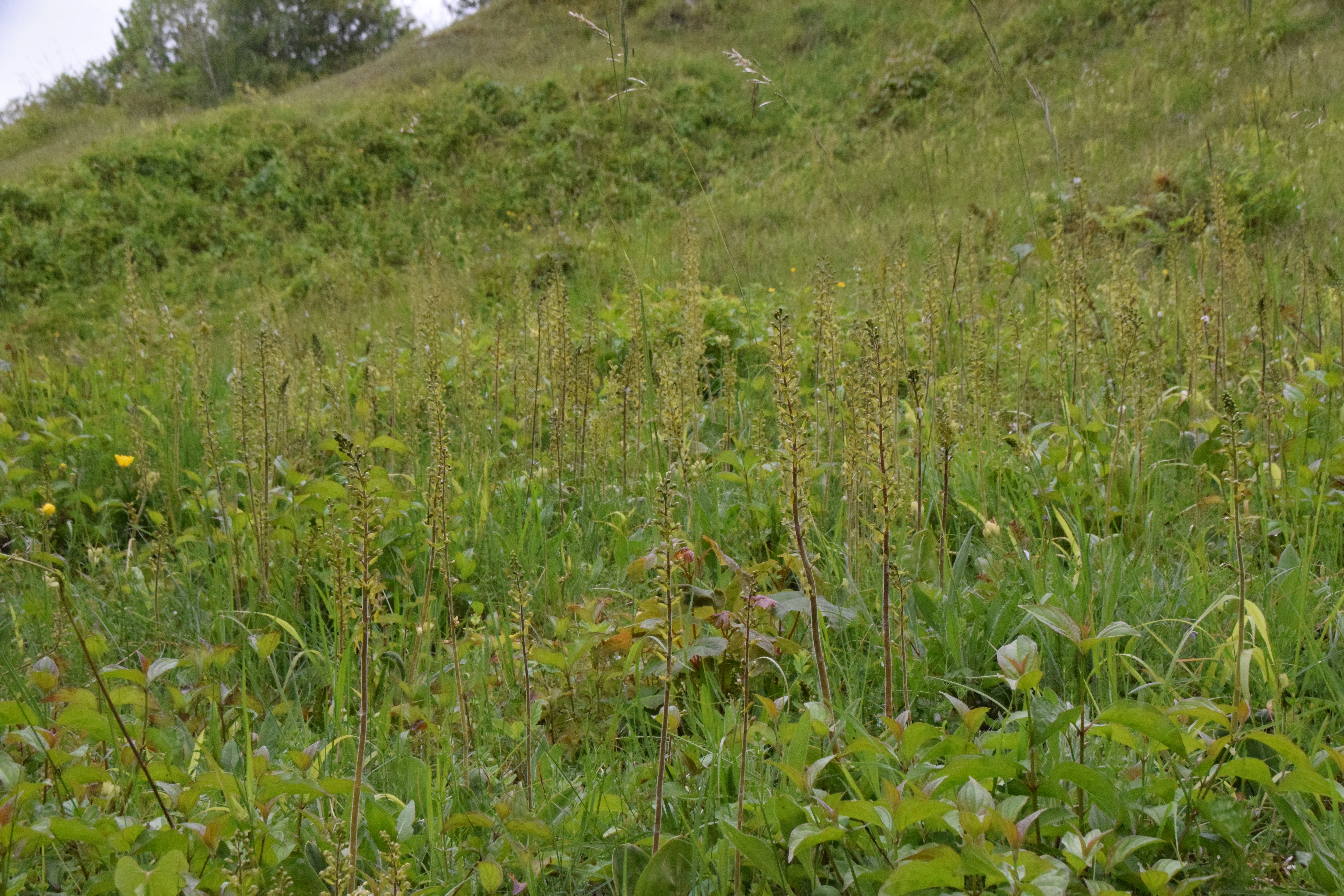
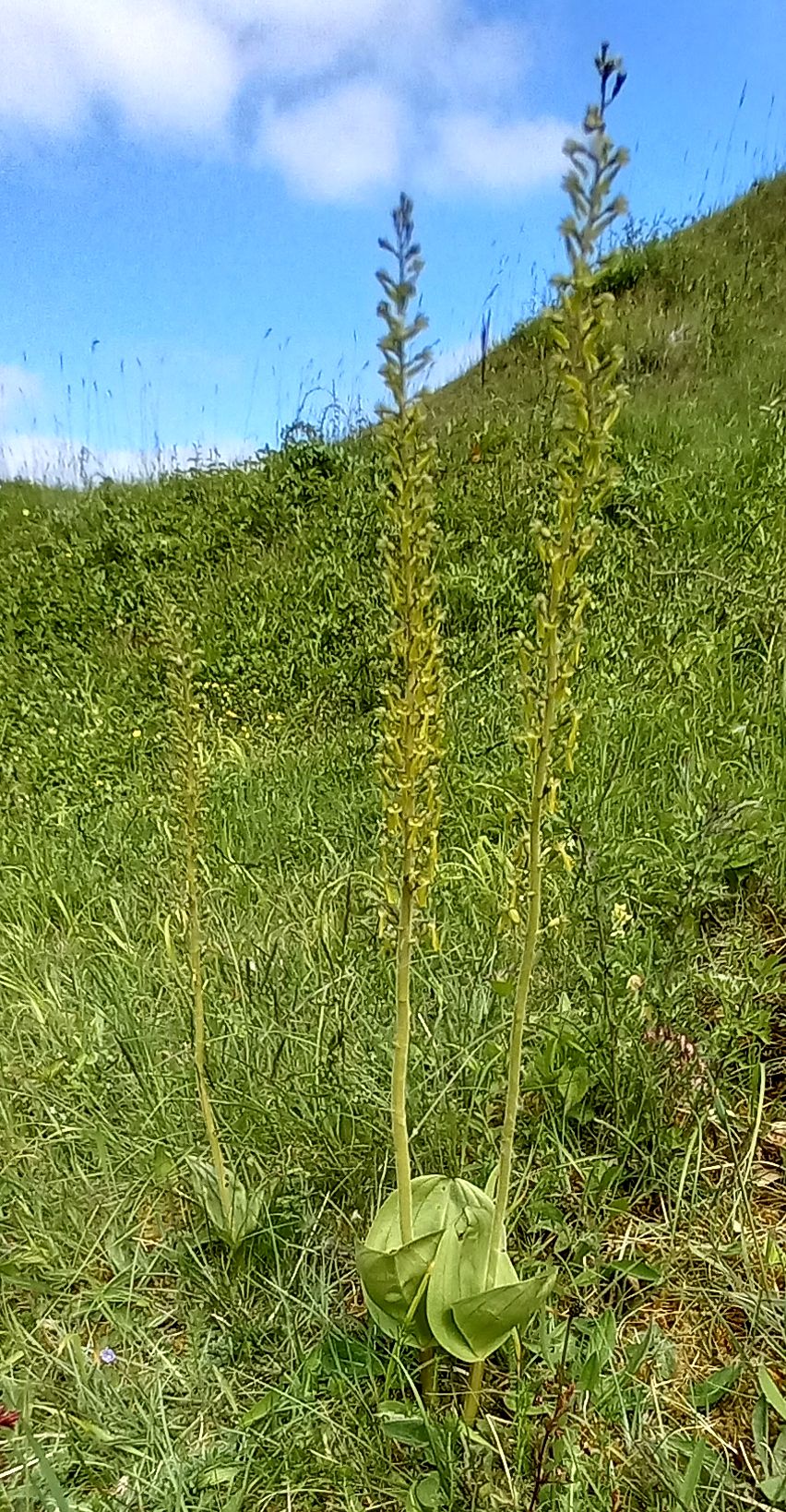
Common Twayblade
On Monday 5th I visited the Warburg Reserve near Henley (see here) that is said to boast BBOWT’s richest array of Orchids, comprising 15 species. My impression from this day was apart from the more frequent wild flower meadow varieties these may take a bit of searching out. Fortunately there is a visitor centre at the main entrance (RG9 6BJ – SU721 878) to assist, where sightings are posted on a poster-sized site plan, and I was also briefed by the warden.
I especially wanted to experience the yet to be seen Bird’s-nest Orchid, a honey-coloured shade lover of Beech woods on limestone soils. These are said to be quite widespread in such habitat, but I located just one today (pictured below). It displayed the species’ special feature of the flowers being clustered towards the top of the stem with just a few spaced more widely lower down. I thought it looked a little past its best but now read this plant typically resembles withered stems from the previous season.
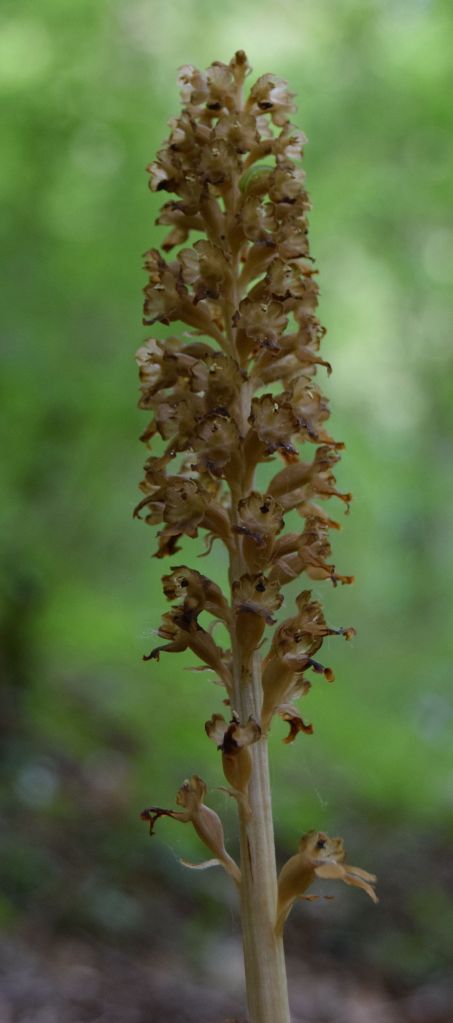
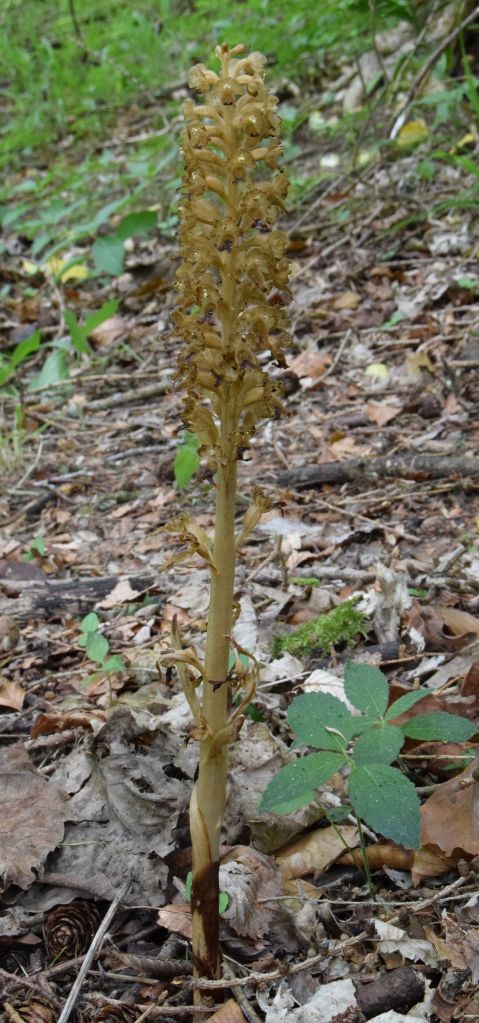
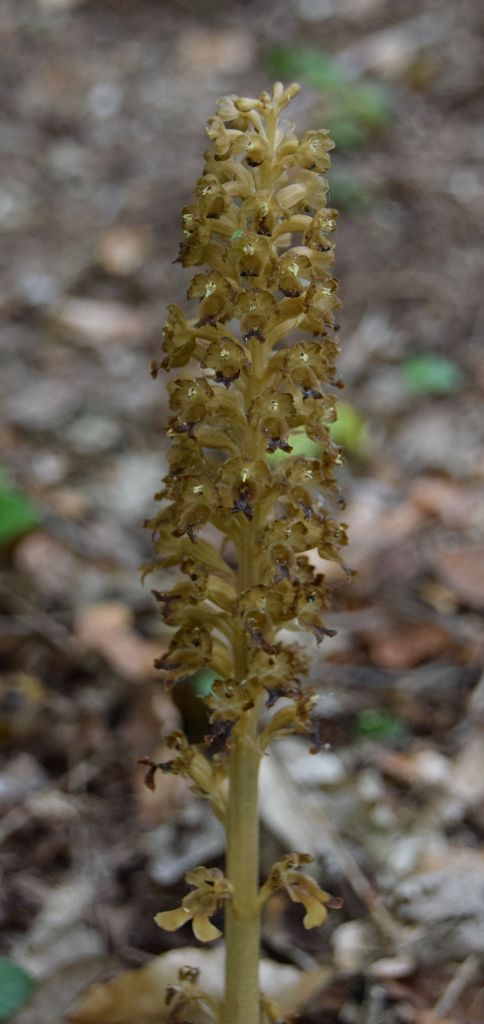


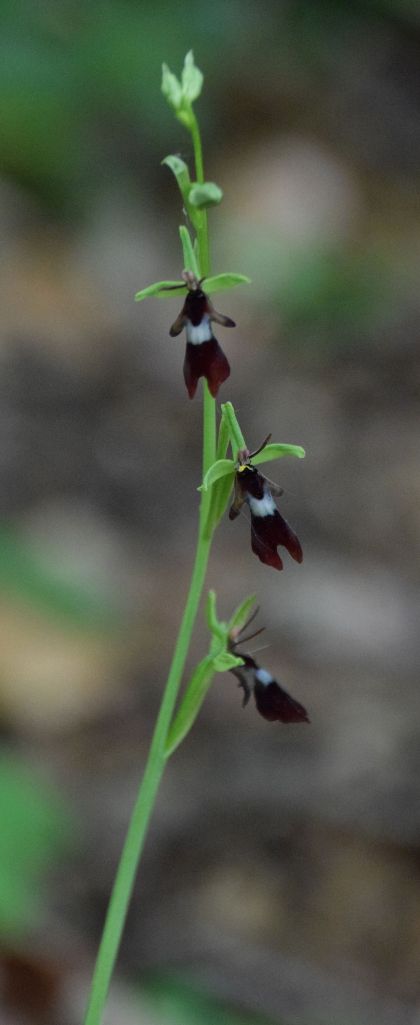
Nearby I also found a single Fly Orchid (above) in the area I was advised to look in, before moving on to seek out more Greater Butterfly Orchid (below) at a field edge to one side of the reserve’s northern access point from Maidensgrove. In between the two locations I walked through some of Warburg’s wild flower meadows, where as at Grangelands young Common Spotted and no doubt other frequent Orchids were emerging from the ground ahead of their annual grand displays.
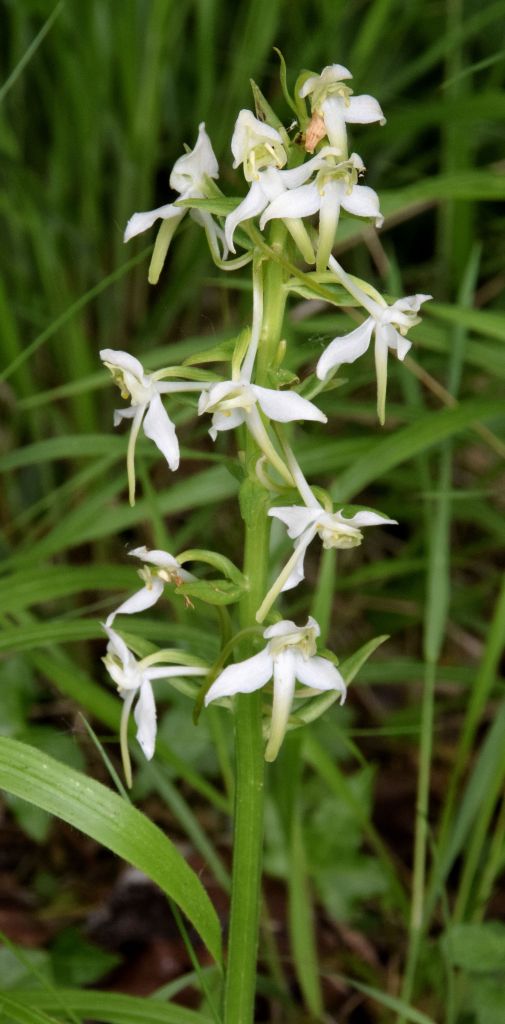
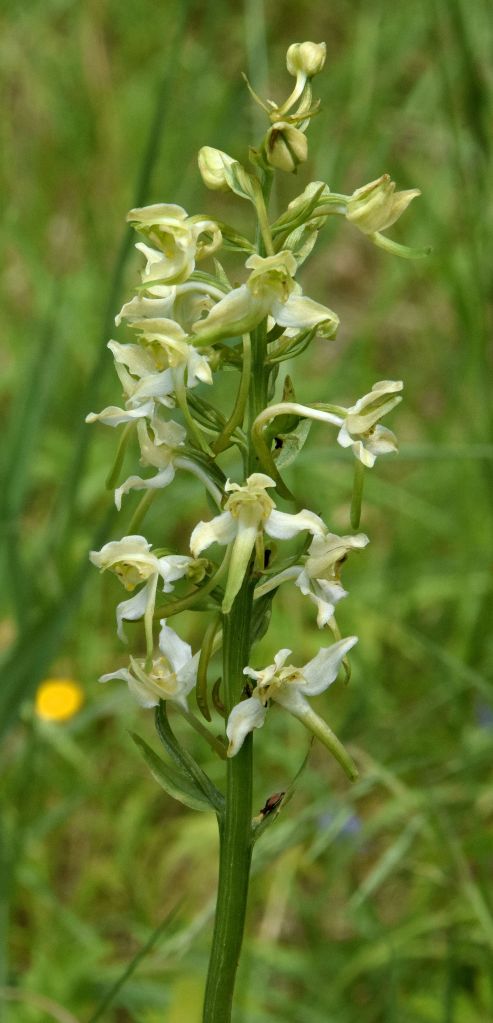
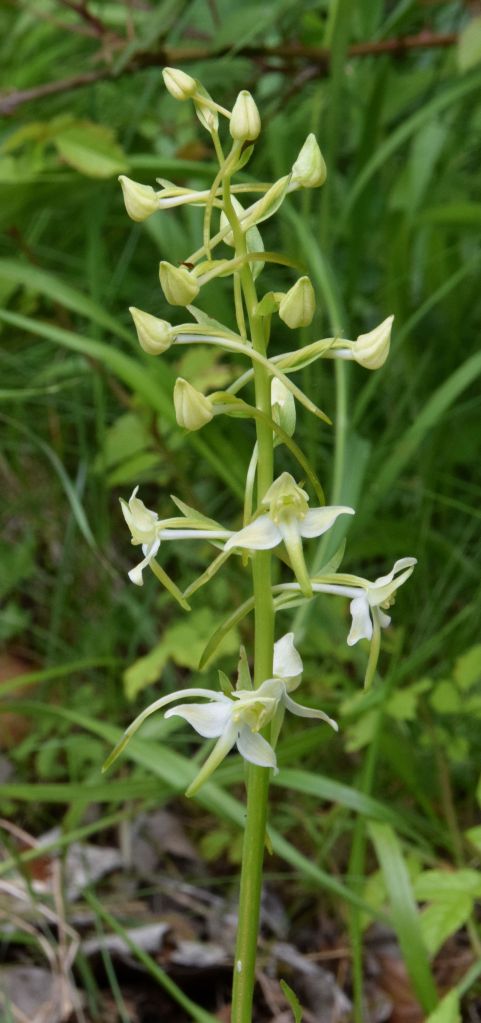
On 14th I paid another visit to Grangelands to experience the Chalk Fragrant and Common Spotted Orchids in full cry. In amongst them, here and there rather more vivid Pyramidal Orchid (pictured below, left) had now entered the mix. One of the more familiar encounters from my casual interest of the past, this is a widespread species of calcareous grassland, flowering from June to August. The clean, bright blooms vary from deep cerise to violet or purple, and as they open the spikes’ shape changes from pyramid to globe. They are pollinated by butterflies, day and night flying moths and become strongly scented in the evening to attract the last of those.
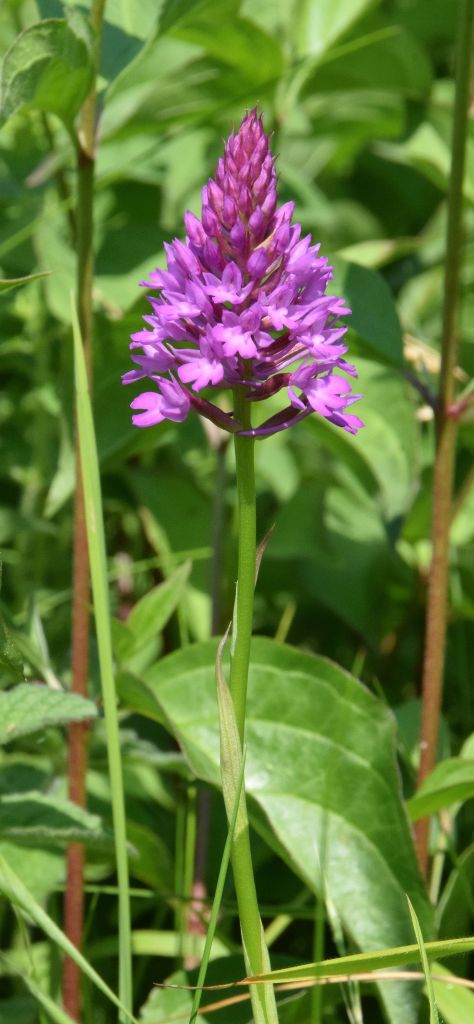
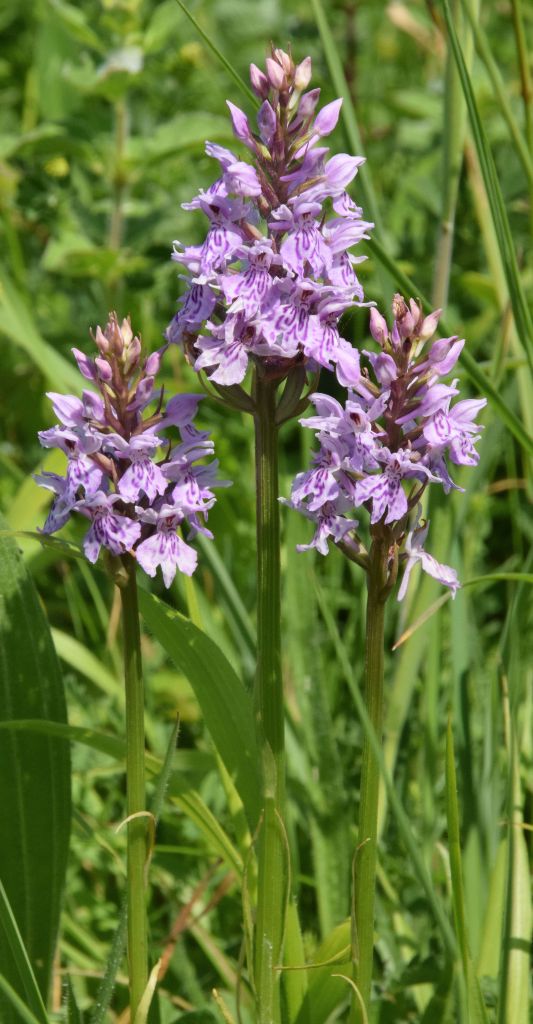
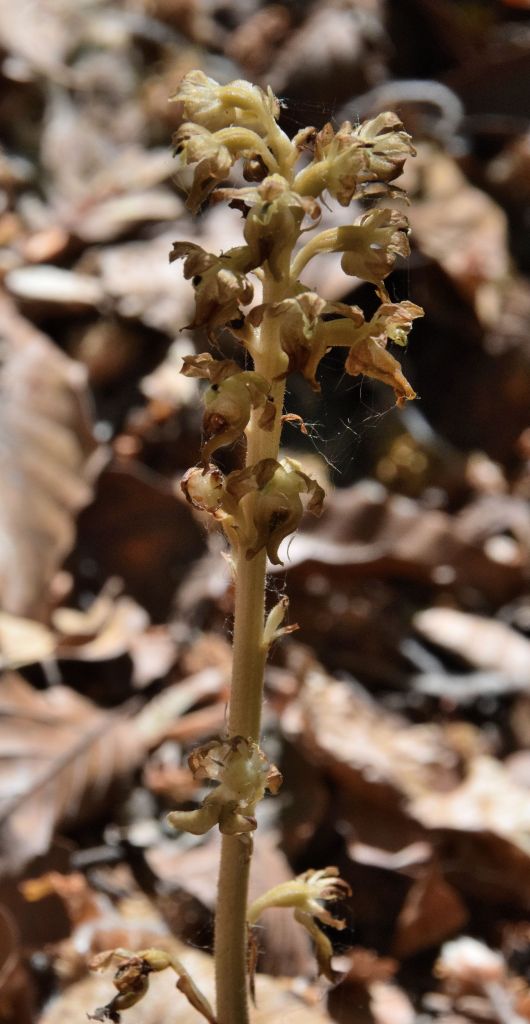
I had been told on the earlier visits here where to locate both Musk and Bird’s-nest Orchid. Though there had been a thundery breakdown in the current heat-wave over the weekend, the former had still not emerged. But I did find one of the latter on a steep Beech wood slope below Pulpit Hill fort and above the reserve’s Rifle Range area. It was much smaller and had an even more gone over look to it (above right) than that earlier Warburg item.
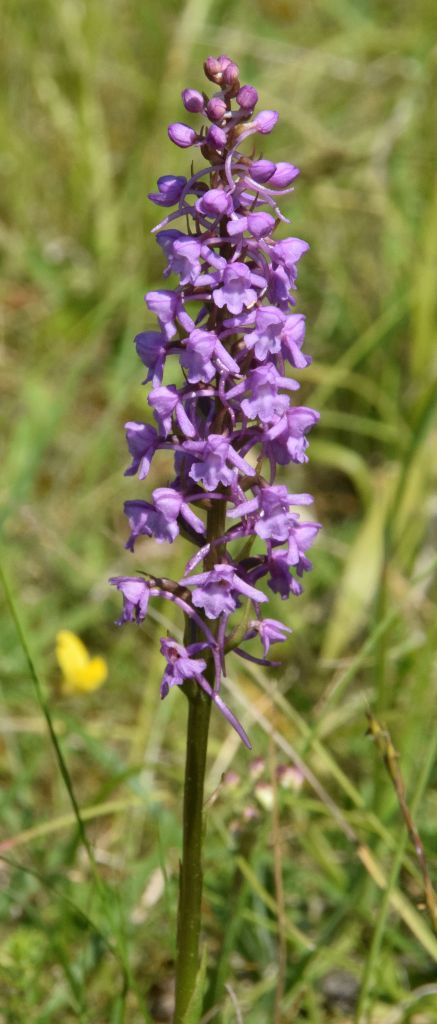
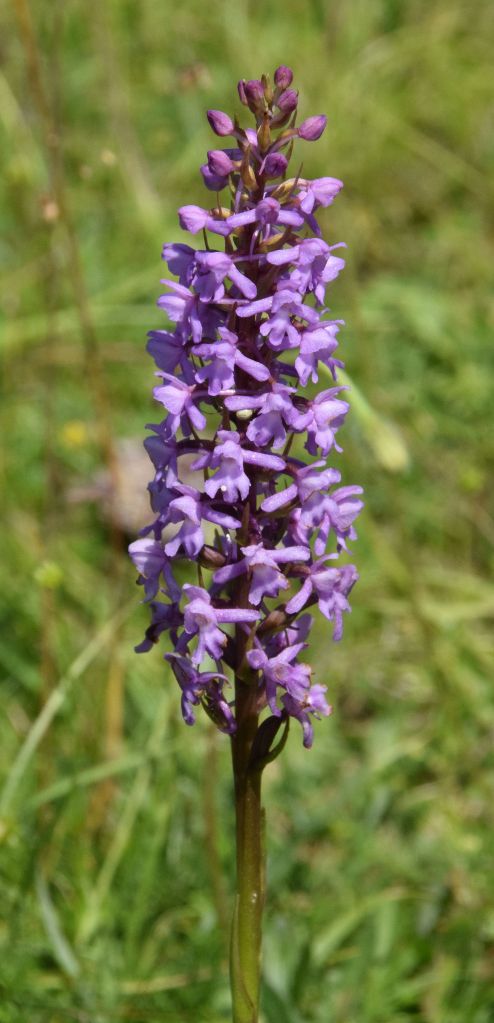
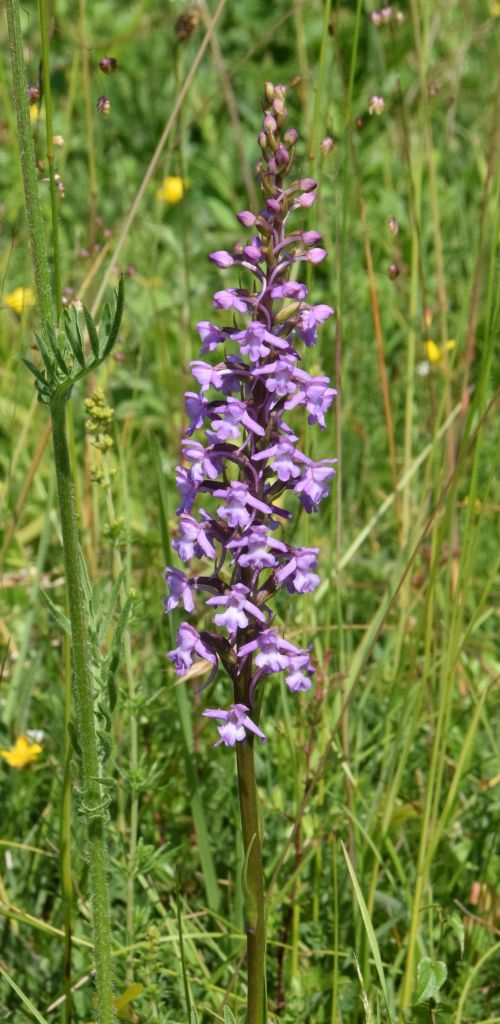
Aston Clinton Ragpits
The display of Chalk Fragrant, Common Spotted and other Orchids at Aston Clinton Ragpits on this day was simply incredible, though difficult to capture adequately in pictures in the glaring sunlight. Of all the sites I have visited in 2023 this is undoubtedly the richest. But I noticed plants were going over quickly in the continued hot, dry conditions of this post. Amongst the Pyramidal Orchids (pictured below) I was pleased to locate a few of the white variant. This is a scarcity in Great Britain but has established some stable colonies, and enquiry revealed it is regular here.
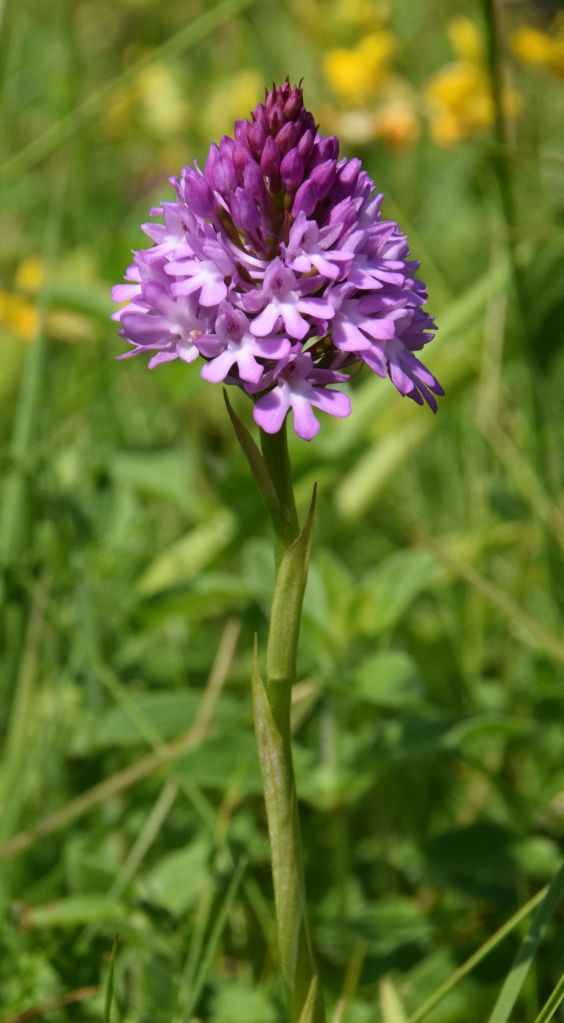


Footnote: Through the second half of June, Pyramidal Orchid was the stand-out interest as I re-visited various Oxon and Bucks sites. It was a very hot weather month that served to cause the big displays of Common Spotted and Chalk Fragrant Orchids to go over quite quickly while the first-named of these three frequent species thrived. Those weather conditions did not suit the Grangelands Musk Orchids that I sought a number of times, eventually finding just three plants that had already gone over soon after my previous attempt. It now remained to cover some late summer Orchids, particularly Helleborines and hence my attention turned elsewhere.

